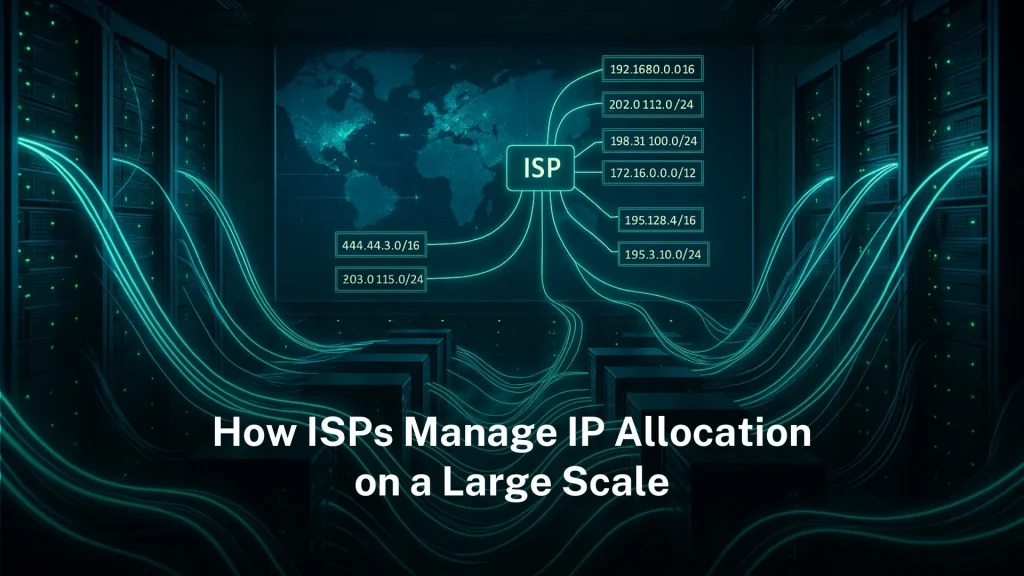- Table of Contents hide
ISPs use hierarchical IP address distribution from registries like IANA and RIRs to give out addresses.
Good IP address management makes sure ISPs have network scalability security and operational efficiency.
The Critical Role of IP Allocation in Large-Scale Networks
The Critical Role of IP Allocation in Large-Scale Networks
Internet Service Providers (ISPs) are the backbone of internet infrastructure they run big networks and make sure millions of users connect to the world’s digital ecosystem one main job of ISPs is managing IP address allocation this process is essential because it lets devices communicate over the internet.
For large ISPs IP address management (IPAM) is a complex ongoing challenge it includes not just giving out new addresses but also using this limited resource well an ISP’s ability to handle this process affects the speed reliability and scalability of the internet services they offer directly.
To know how ISPs do this task you need to look into the details of the IP allocation process the role of registries and the technology ISPs use to keep everything running smoothly.
The RIRs and Hierarchical Distribution
Each RIR acts like a regional wholesaler it gives large blocks of IP addresses to Internet Service Providers ISPs then give these addresses to their customers the process is hierarchical IANA is at the top then the RIRs then the ISPs.
Usually an ISP gets a block of IP addresses from an RIR based on what they need the addresses are split into smaller subnets to give to customers larger ISPs need more IP space because their networks are bigger.
For example a regional ISP that serves a small city might get a /24 block this block has 256 addresses a larger national ISP might get a /16 block this block has 65,536 addresses to cover their wider service area.
Greg Shatan chair of the Intellectual Property Constituency at ICANN says the allocation process makes sure each ISP has enough resources to provide service it also stops people from hoarding IP space.
The Complexities of IPv4 Exhaustion
IPv4 address space is running out this brings big challenges for ISPs the lack of IPv4 addresses has made many ISPs look for other solutions like using IPv6 using Network Address Translation (NAT) or getting IP addresses from a secondary market.
Shatan says IPv4 exhaustion is a big issue ISPs have to be very strategic when giving out addresses to make sure they don’t run out too early.
Many ISPs have started using IPv6 to make their networks ready for the future but moving from IPv4 to IPv6 is slow many old devices and networks still use IPv4 IPv6 adoption is important for the internet to keep growing but this shift has been slow and complex for ISPs.
Best Practices for Managing IP Addresses
To manage IP allocation well ISPs use IP Address Management (IPAM) systems these systems are made to automate the allocation configuration and management of IP addresses in the ISP’s network modern IPAM systems let ISPs map their network infrastructure and track how addresses are used they make sure no addresses are wasted.
Another best practice is subnetting this means dividing large IP address blocks into smaller easier-to-manage units this lets ISPs give subnets to different departments or types of customers it helps use available address space better.
Meynell says it’s all about using your address space efficiently ISPs that don’t manage their IP resources well might run out of space faster than they expect.
The Rise of the IPv6 Transition
Even though IPv4 exhaustion is a problem IPv6 adoption is going up little by little IPv6 has a huge address pool it has about 340 undecillion addresses this is more than enough to handle the growing need for IP addresses.
Moving to IPv6 needs changes from both ISPs and customers it also needs updating network infrastructure many ISPs already offer IPv6 support to new customers they still manage their IPv4 resources for existing users at the same time.
Meynell says the shift to IPv6 is slow but it has to be done it’s not just about IP addresses it’s about getting the whole internet infrastructure ready for the future.
How ISPs Utilise IP Address Trading
As IPv4 addresses get scarcer a secondary IP address market has come up in this market ISPs and organisations can buy and sell IP address blocks that are no longer needed or are more than they require this market helps ISPs get the resources they need without only depending on RIR allocations.
The IP address market is strictly regulated both buyers and sellers have to work with brokers and follow legal rules to make sure transactions are real but IP address trading has raised worries some people are concerned that a few groups might take control of most address blocks this could cause problems with network fairness and competition.
Shatan says IP address trading can help ISPs manage their resources it also opens the door to abuse if it’s not regulated carefully the possibility of hoarding IP addresses is a worry.
Security Considerations in IP Address Management
Good IP address management also includes thinking about security ISPs have to make sure the IP addresses they give to customers are protected well this stops misuse like DDoS attacks IP address spoofing or other harmful activities.
ISPs use tools like Border Gateway Protocol (BGP) monitoring and DNS security extensions (DNSSEC) these tools help protect their allocated IP space they also make sure address assignments are valid.
Meynell says security is always a top concern for ISPs that manage IP resources a poorly managed IP address pool can let cyberattacks and data breaches happen.
The Role of ISPs in Global Internet Governance
ISPs are important in global internet governance they help shape the internet’s future through their work in IP address allocation and management ISPs depend on regional registries for address space they also take part in global talks about internet governance policies.
For example ICANN and the IETF (Internet Engineering Task Force) often talk to ISPs about the future of internet protocols and how to manage IP resources these discussions make sure the policies in place can support the growing need for internet connectivity.
Shatan says ISPs are not just service providers they are part of shaping the internet’s future their input is important to make sure the internet stays open accessible and secure.
FAQs
1. What is IP address allocation?
IP address allocation is the process where ISPs and organisations get unique addresses for devices these addresses let devices connect to the internet they are essential for communication across the network.
2. Why is IPv4 exhaustion a problem?
IPv4 exhaustion means there are not enough IPv4 addresses left this happens because more and more devices connect to the internet the limited address space has made it necessary to find new solutions like adopting IPv6.
3. Why do ISPs use subnetting?
ISPs use subnetting to divide large IP address blocks into smaller units these smaller units are easier to manage subnetting lets ISPs give specific subnets to different departments or customer groups it helps use available IP space more efficiently and reduces waste.
4. What is NAT and how does it help with IPv4 exhaustion?
NAT stands for Network Address Translation it lets multiple devices on a private network share a single public IPv4 address this means ISPs don’t need to give a unique public IPv4 address to every device it helps stretch the remaining IPv4 address space and delays the impact of IPv4 exhaustion.
5. What is IP address trading?
IP address trading is the process where ISPs and organisations buy and sell IPv4 address blocks this market started because IPv4 addresses are scarce it helps ISPs meet their needs for IP addresses.










Leave a Reply